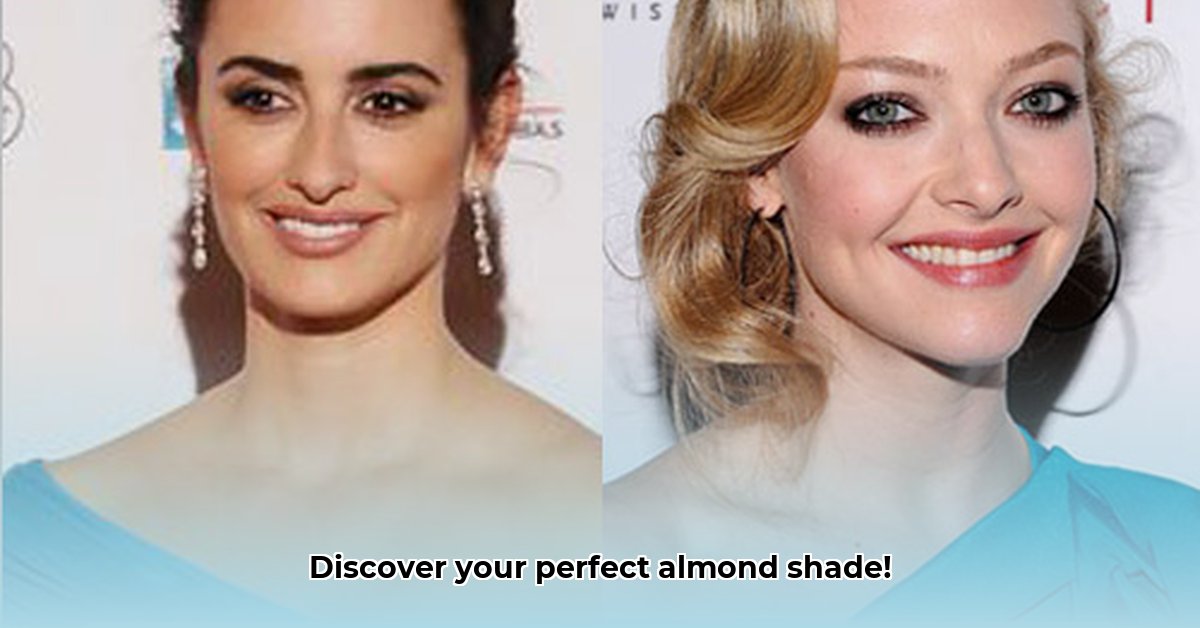Confused about choosing the right makeup and skincare for your almond skin tone? You’re not alone! This guide breaks down everything you need to know to find the perfect match – from understanding your undertone to picking the best foundation and skincare routine, even tackling those pesky hyperpigmentation issues. We’ll give you simple steps to follow, so you can easily create a routine that helps you look and feel your best. For more information on identifying your skin tone, check out this helpful guide on almond skin tones. Get ready to glow!
Warm vs Cool Almond Skin Tone: Unlocking Your Natural Glow with the Perfect Skincare Routine
Almond skin—that gorgeous medium-to-light brown—comes in two main varieties: warm and cool. Knowing which one you have is like finding the perfect key to unlock your most radiant self. It completely changes how you choose makeup and skincare. Let’s dive in and discover the secrets to radiant skin using personalized techniques!
Deciphering Your Undertone: Warm or Cool Skin Tone Using the Wrist Vein Test
The secret lies in your undertone—that subtle hint of color peeking through your skin. Think of it as the base color beneath the surface. See hints of gold, olive, or yellow? You’re probably warm-toned. If your skin leans more towards pink, red, or bluish, you’re likely cool-toned.
Here’s an easy test: Check out the veins on your inner wrist. Bluish or purplish veins suggest a cool undertone; greenish veins point to a warm one. Another trick? Hold a gold and silver piece of jewelry next to your skin. Which one makes your skin look brighter and more alive? Gold usually flatters warm undertones, while silver complements cool ones.
Another method involves considering how your skin reacts to the sun. If you tend to tan easily and rarely burn, you likely have warm undertones. If you burn easily or turn pink before tanning, you’re more likely to have cool undertones. You can also try the white fabric test. Hold a bright white cloth up to your face, then try an off-white or cream-colored fabric. If your skin looks better against the bright white, you likely have cool undertones. If it looks better against the cream or off-white, you probably have warm undertones.
Tailoring Your Skincare Routine: Warm vs. Cool Almond Skin for Optimal Skin Health
While the basics—gentle cleansing, moisturizing, and always using at least SPF 30 sunscreen (a protective barrier from harmful UV rays)—stay the same for everyone, your undertone influences specific skincare needs. Did you know that consistent sunscreen use can reduce signs of aging by 24%, according to a 2013 study in the Aesthetic Surgery Journal? Look for broad-spectrum sunscreens that protect against both UVA and UVB rays. Mineral sunscreens with zinc oxide or titanium dioxide are excellent choices, especially for sensitive skin.
For Warm Almond Skin:
Think hydration, hydration, hydration! That golden or olive undertone can sometimes appear drier than cool tones. Look for products packed with ingredients like hyaluronic acid (a super hydrator) and ceramides (which help reinforce your skin’s natural barrier). Lightweight lotions and cream-based cleansers are usually a good choice. If sun damage or dark spots are a concern, a Vitamin C serum can be your new best friend—it’s a powerful antioxidant that brightens and protects. Consider incorporating natural oils like jojoba or argan oil for added moisture and radiance.
For Cool Almond Skin:
Cool almond skin sometimes tends towards redness. So, focus on calming and soothing your skin. Look for products with ingredients like aloe vera (which is famously soothing) or chamomile (known for its calming properties). Products labeled “sensitive skin” are usually a safe bet, as they tend to be gentler. Gel-based moisturizers and foaming cleansers can help maintain balance. Ingredients like niacinamide can also help reduce redness and inflammation.
Makeup Magic: Finding Your Perfect Foundation Shade for Almond Skin
Choosing the right foundation is where understanding your undertone really pays off.
Warm Almond Skin:
Look for foundations with golden, yellowish, or peachy undertones. Think shades like beige, honey, or caramel—these will blend seamlessly with your skin. When trying out foundations, test them in natural light to see how they truly look on your skin.
Cool Almond Skin:
Opt for foundations with pink, rosy, or neutral beige undertones. Look for descriptions like “ivory,” “rose beige,” or “neutral beige.” These will give you a more natural-looking finish.
Here’s a handy table to summarize:
| Undertones | Foundation Shades | Blush Shades | Bronzer Shades |
|---|---|---|---|
| Warm | Golden, Honey, Caramel | Peach, Apricot, Coral | Golden Brown, Bronze |
| Cool | Rose Beige, Ivory, Neutral | Pink, Rose, Mauve | Light Brown, Taupe |
Remember, these are just guidelines; experiment to find what truly makes you feel confident and beautiful! Always swatch foundation on your jawline, not your hand, to get the best color match.
Taming Hyperpigmentation: A Shared Concern and Effective Solutions
Both warm and cool almond skin types can be prone to hyperpigmentation (dark spots or uneven skin tone). The good news? Prevention is key! Use a broad-spectrum sunscreen with an SPF of 30 or higher daily, rain or shine. This is non-negotiable. Consider incorporating products with ingredients like niacinamide (a powerhouse ingredient that evens skin tone) or arbutin (which helps to fade dark spots) into your routine. Azelaic acid is another excellent choice for reducing hyperpigmentation and redness. If you’re struggling with significant hyperpigmentation, a dermatologist can offer personalized treatment options like chemical peels, microdermabrasion, or laser therapy.
Ultimately, understanding whether you have a warm or cool almond skin tone empowers you to choose skincare and makeup that truly enhances your beauty. It’s all about celebrating your unique skin and keeping it happy and healthy. Remember, this is a journey of discovery, so have fun experimenting and finding what works best for you!
Here are some core insights for radiant almond skin:
- Determine Your Undertone: Identify your warm or cool undertones using simple tests like the wrist vein test or jewelry comparison.
- Tailor Your Skincare: Adjust your skincare routine based on your undertone, focusing on hydration for warm tones and soothing for cool tones.
- Prioritize Sun Protection: Use broad-spectrum sunscreen daily to prevent hyperpigmentation, a common concern for almond skin.
Best Vitamin C Serum for Almond Skin with Warm Undertones for Brighter Skin
Finding the best vitamin c serum for almond skin with warm undertones can feel like searching for a needle in a haystack. But it doesn’t have to be! Let’s break down how to find your perfect match.
Understanding Your Warm Almond Undertones for Targeted Skincare
First things first: What exactly makes your almond skin tone “warm”? Warm undertones often manifest as golden, yellowish, or peachy hues. Your skin might tan easily, and your veins appear more olive or green than blue. Knowing these nuances is crucial.
Why Vitamin C? Unveiling the Benefits of Vitamin C Serum
Vitamin C is a powerhouse ingredient. It brightens, evens skin tone, boosts collagen production, and protects against sun damage. But not all Vitamin C is created equal. Different formulations exist, each with unique strengths:
- L-Ascorbic Acid: The most potent form, but can be unstable and irritating for sensitive skin. Look for formulations with added antioxidants like Vitamin E and ferulic acid to improve stability.
- THD Ascorbate (Tetrahexyldecyl Ascorbate): A more stable and gentler option, making it ideal for those with sensitive skin.
- Magnesium Ascorbyl Phosphate (MAP): Another stable derivative, often a good choice for sensitive skin and those new to Vitamin C serums.
Choosing Your Serum: A Step-by-Step Guide for Optimal Absorption
- Identify Your Skin Type: Is your skin oily, dry, combination, or sensitive? This impacts serum selection. Sensitive skin calls for gentler forms like THD or MAP. If you have oily skin, look for lightweight, water-based formulations.
- Check the Concentration: Aim for a Vitamin C concentration between 10-20%. Higher isn’t always better; it can lead to irritation. Start with a lower concentration (10%) and gradually increase if your skin tolerates it well.
- Look at the pH: The ideal pH for Vitamin C absorption is around 3.5. Check the product label. A lower pH usually means better absorption.
- Consider Supporting Ingredients: Look for antioxidants like Vitamin E or ferulic acid. These boost Vitamin C’s effectiveness and stability. Hyaluronic acid can also be a great addition for added hydration.
- Patch Test: Before applying to your entire face, test a small area for any reactions. Wait 24-48 hours to see if any irritation occurs.
What to Avoid: Harmful Additives in Vitamin C Serums
Avoid products with overly long ingredient lists packed with unknown chemicals or harsh preservatives. Steer clear of added fragrances and dyes, which can irritate sensitive skin. Look for brands that prioritize transparency.
Product Recommendations (Examples) of Effective and Safe Vitamin C Serums
(
- Plant-based Diet Colitis Remission: Success Stories - December 18, 2025
- Plant Based Diet Breast Cancer: Research-Based Benefits - December 16, 2025
- Plant-Based Diet Ulcerative Colitis Remission: Proven Benefits - December 15, 2025










